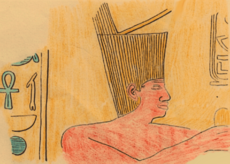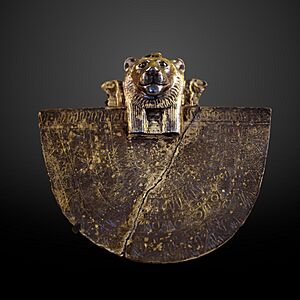Osorkon IV facts for kids
Quick facts for kids Osorkon IV |
|
|---|---|
| Shilkanni, So | |

Relief thought to show Osorkon IV, from Tanis
|
|
| Pharaoh | |
| Reign | 730 – 716 BC (22nd Dynasty) |
| Predecessor | Shoshenq V (most likely) or Pedubast II |
| Successor | Unknown |
| Father | Shoshenq V (possibly) |
| Mother | Tadibast III |
Usermaatre Osorkon IV was an ancient Egyptian pharaoh who ruled during a very busy time in history. He is usually seen as the last king of the 22nd Dynasty. However, his real power was mostly limited to the cities of Tanis and Bubastis in Lower Egypt. Many historians believe he is the same person as King Shilkanni mentioned in ancient Assyrian writings. He might also be the biblical So, King of Egypt from the Bible.
Osorkon ruled when ancient Egypt was divided into many small kingdoms. The Nile Delta area, where he ruled, had many small Libyan and Meshwesh (another group of people) territories. As the last ruler from Tanis, he controlled the eastern part of these lands. This area was often involved in big political and military events happening in the Near East. During his time, he had to deal with the powerful Kushite King Piye, who conquered Egypt. Osorkon IV also faced threats from the strong Neo-Assyrian Empire to his east.
Contents
Osorkon IV: An Egyptian Pharaoh
Ruling in a Divided Egypt
Osorkon IV became pharaoh in Tanis around 730 BC. He likely took over after his father, Shoshenq V, who was also part of the 22nd Dynasty. However, some experts think he belonged to a different group of rulers, the 23rd Dynasty. His mother was Tadibast III, as shown on a special gold shield piece found in the Louvre museum.
Osorkon's kingdom was quite small. It only included the area around Tanis and Bubastis in the eastern Nile Delta. Other Libyan princes and chiefs ruled their own small areas nearby, outside of his control.
Facing the Kushite King Piye
Around 729 BC, soon after Osorkon became king, he faced a huge challenge. Piye, the Kushite pharaoh from Nubia (part of the 25th Dynasty), began to conquer Egypt. Osorkon IV joined other rulers from Lower and Middle Egypt, like Nimlot and Iuput II, to fight against Piye. Their leader was Tefnakht, the Chief of the West.
But Piye's army was too strong. One by one, the Egyptian rulers surrendered. Osorkon IV wisely went to the Temple of Ra in Heliopolis and showed respect to Piye. Other rulers soon followed his example. Piye allowed them to keep their lands and power, but they had to accept him as their new ruler.
Dealing with the Assyrian Empire
Egypt also faced a big threat from the powerful Neo-Assyrian Empire to its east.
Israel's Plea for Help
In 726 BC, Hoshea, the last king of Israel, stopped paying tribute (a payment to a stronger ruler) to the Assyrian King Shalmaneser V. The Bible says Hoshea asked "So, King of Egypt" for help. This "So" was most likely Osorkon IV.
For reasons we don't know, Osorkon did not help Hoshea. Maybe he wanted to stay neutral with the powerful Assyrians, or perhaps he just didn't have enough power. Hoshea was defeated, and the Kingdom of Israel was destroyed. Many Israelites were taken to Assyria as exiles.
Battle at Raphia and Tribute
In 720 BC, a rebellion against the new Assyrian King Sargon II broke out in Palestine. King Hanunu of Gaza asked "Pharaoh of Egypt" (likely Osorkon IV) for help. Assyrian records say that Osorkon did send an army commander named Reʾe and troops to help.
However, the Egyptian and Palestinian forces were defeated in a battle at Raphia. Reʾe fled back to Egypt. Raphia and Gaza were looted, and Hanunu was killed by the Assyrians.
In 716 BC, Sargon II's army came very close to Egypt's borders. Feeling directly threatened, Osorkon IV (called Shilkanni by the Assyrians) chose a smart approach. He met Sargon II near the "Brook of Egypt" (probably el-Arish). Osorkon gave Sargon a gift of "twelve large horses of Egypt," which Sargon said were unmatched in Assyria. The Assyrian king liked the gifts and did not attack Osorkon IV.
The End of Osorkon's Rule
We don't have any records of Osorkon IV after 716 BC. Some discoveries suggest that soon after this, Bocchoris (Bakenrenef) of the 24th Dynasty might have taken over Tanis, replacing Osorkon.
By 712 BC, Piye's successor, Shebitku, had become the sole ruler of Egypt. When King Iamani of Ashdod tried to find safety in Egypt from Sargon II, Shebitku was in charge. He sent Iamani back to the Assyrians in chains. This means Osorkon IV was likely dead before that time. A few years later, a man named Gemenefkhonsbak, possibly related to the old 22nd Dynasty, became a prince in Tanis.
Who Was King So?
Historians believe that the name Shilkanni is an Assyrian way of saying (O)sorkon, which means Osorkon IV. This idea was first suggested in 1956 and is accepted by many experts. The Assyrians called Shilkanni "King of Musri", which is now known to mean Egypt. So, the "Pharaoh of Musri" who helped Hanunu of Gaza in 720 BC could only have been Osorkon IV.
The identity of the biblical King So is a bit less certain. Many scholars think it's a shortened form of (O)so(rkon), referring to Osorkon IV. However, some believe "So" might refer to the city of Sais, and therefore to King Tefnakht.
How We Know About Osorkon IV
We know about Osorkon IV from Assyrian documents, where he is called Shilkanni and other names. He is also likely mentioned in the Bible as King So. However, ancient Egyptian lists of kings, like those by Manetho, don't seem to mention him.
He is clearly shown on the famous Victory Stela of Piye. This stone carving shows Osorkon IV bowing down to Piye, along with other defeated rulers. Another important find is a small gold shield piece (called an aegis) of the goddess Sekhmet. It was found in Bubastis and names a King Osorkon, son of Queen Tadibast. Since no other King Osorkon had a mother with that name, this must refer to Osorkon IV.

See also
- Pharaohs in the Bible for other historical or possible pharaohs mentioned in the Bible


